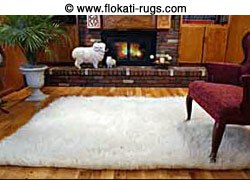Fabulous design. Cutting edge looks. Interesting twists in color, fabric, and texture. These are all elements inherent in design that's ecologically sound. Yes, your creativity can have free reign even as you make choices that help protect the planet. Increasingly, manufacturers are creating products that have minimal impact on the environment, whether because they're made from organically-grown cotton or because they're made with renewable resources. We think environmentally friendly design is so important that we recently added a Green Design lesson to the NYIAD Complete Course in Interior Design.
In our "Decorating Green" column we'll look at a sustainable, low-impact element of design in each issue of "Designer Monthly." We hope these articles will help us all help the planet and the many creatures that share it with us.
Who knew that a trip back to the 1970s would produce a sustainable, green décor essential?
The flokati rug, ubiquitous in the suburban living rooms of the 1970s that also held Wegner chairs and op art, is making a comeback, in part thanks to the fact that flokati rugs can be a greener way to warm a floor than many other types of rugs.

It doesn't hurt that in the right room, a flokati rug looks great, and it really doesn't hurt that the price tends to be lower than what you'd pay for a woven wool rug.
Even though we think of it as a throwback to 1970s design, the flokati actually dates back even further — centuries, in fact. The genuine articles are rugs that are hand made from sheep's wool, and apparently the tradition began in the 5th century in Samarina, Greece, the highest village on the Pindos Mountains, where many flokati rugs are still made today.
Back then, the heavy wool rugs were used by shepherds to keep warm while outdoors. Today, they can help keep home heating costs down by providing a warm and wooly floor covering.
The flokati rug is not to be confused with a shag rug, which can be made of virtually anything. A flokati rug is only made with heavy sheep wool, and comes in several grades, depending on how thick and heavy a rug you want.
The rugs are categorized according to weight, and the weight is counted by square meter. They range from 1,400 grams per square meter to the heaviest, most luxurious at 4,000 grams per square meter. Of course, the price climbs in direct relation to the grams-per-square meter.


NYIAD Top Tip
The rugs are lush, sexy, and a little bit kitchsy — but in a good way. With the right furniture, they can bring in a whimsical note. We think they look best with mid-century modern, such as an Eames chair. We like the natural, off-white color best, but you can also find them in bright white, and in just about every other color imaginable.

Many people hesitate to buy a flokati because they worry about cleaning, but in actuality, they're quite easy to clean, and can be easier and less expensive to clean than a woven wool rug. Makers of the rugs advise owners to shake out the rug periodically to remove dust and dirt particles, and then to hand or machine wash in cold water with a mild wool-appropriate soap. The only thing you don't want to do is vacuum the rug with a rotating vacuum head, because the furry wool will get caught in the vacuum. It would be a little like trying to vacuum your cat, something we do not recommend.
The best thing about the flokati, other than the great look it can bring to a room, is that it's made of a renewable resource, and if you shop carefully, you can easily buy one that is not chemically treated. The only questionable thing in terms of the "green" factor is that questions have been raised about the treatment of the sheep. There is an on-going concern about humane treatment of sheep on wool farms, just as there is concern about treatment of chickens in egg farms.
Some people have said that Australian wool farms tend to be less humane than others, and at least one flokati manufacturer will only work with farms from other countries. But these concerns about wool production would be the same with any wool products, not just with flokati rugs.







